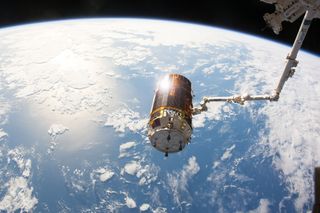
Japanese Cargo Craft Falls to Earth After Failed Space-Junk Experiment
A Japanese cargo craft fell back to Earth Sunday (Feb. 5) after delivering supplies to the International Space Station (ISS) and attempting a novel space-junk experiment.
The spacecraft, named HTV-6, arrived at the space station in December filled with 5 tons of food, water, clothes, science experiments and other gear. It intentionally burned up in Earth's atmosphere at 10:06 a.m. EST on Sunday (12:06 a.m. Japan StandardTime), according to the Japan Aerospace Exploration Agency. The HTV-6 spent 45 days docked at the station's Harmony module while Expedition 50 crewmembers unloaded the cargo and filled the empty space with nonrecyclable trash.
On Sunday, the spacecraft and all that rubbish was incinerated in Earth's atmosphere as HTV-6 made a controlled deorbit, safely plunging down over the Pacific Ocean.

After departing from the space station on Jan. 27, HTV-6 spent a week orbiting the Earth 12 miles (19 kilometers) below and 23 miles (37 km) ahead of the ISS to keep a safe distance while testing out a new technology for removing space junk, or orbital debris, from Earth's orbit.
The Kounotori Integrated Tether Experiment (KITE) flunked its first orbital test when a glitch prevented it from properly deploying a 700-meter-long (2,300 feet) electrodynamic tether made to grab pieces of space junk, the Japan Aerospace Exploration Agency (JAXA) reported Tuesday (Jan. 31).
JAXA's space-junk-removing tether is designed to latch on to a piece of orbiting debris before pulling it down into Earth's atmosphere for a fiery disposal. The agency continued to troubleshoot and attempt to deploy the tether through Saturday (Feb. 4), but alas, the Japanese experiment burned up in the atmosphere without a space-junk tether success.
Email Hanneke Weitering at hweitering@space.com or follow her @hannekescience. Follow us @Spacedotcom, Facebook and Google+. Original article on Space.com.
Get the Space.com Newsletter
Breaking space news, the latest updates on rocket launches, skywatching events and more!
Join our Space Forums to keep talking space on the latest missions, night sky and more! And if you have a news tip, correction or comment, let us know at: community@space.com.

Hanneke Weitering is a multimedia journalist in the Pacific Northwest reporting on the future of aviation at FutureFlight.aero and Aviation International News and was previously the Editor for Spaceflight and Astronomy news here at Space.com. As an editor with over 10 years of experience in science journalism she has previously written for Scholastic Classroom Magazines, MedPage Today and The Joint Institute for Computational Sciences at Oak Ridge National Laboratory. After studying physics at the University of Tennessee in her hometown of Knoxville, she earned her graduate degree in Science, Health and Environmental Reporting (SHERP) from New York University. Hanneke joined the Space.com team in 2016 as a staff writer and producer, covering topics including spaceflight and astronomy. She currently lives in Seattle, home of the Space Needle, with her cat and two snakes. In her spare time, Hanneke enjoys exploring the Rocky Mountains, basking in nature and looking for dark skies to gaze at the cosmos.









